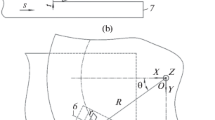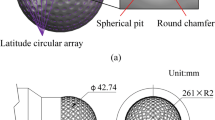Abstract
This paper provides an analytical solution to describe the trajectories of fixed cutting edges in machining spherical surfaces when the relative motion between the cutting edges and the workpiece surface involves three independent rotations. The concepts of surface coverage ratio and trajectory uniformity were introduced to measure the efficiency of machining the curved surfaces. The effects of the maximum half-swing angle, rotational speeds and rotational direction of the tool and workpiece on the uniformity of the trajectory pattern were analysed in detail. It was found that with the aid of the analytical solution, an optimal machining condition can be obtained, which enables a uniform distribution of the cutting edge trajectories and a good surface coverage in a short period of machining time.
Similar content being viewed by others
References
Zhang B, Nakajima A (2000) Spherical surface generation mechanism in the grinding of balls for ultraprecision ball bearings. Proc IME J J Eng Tribol 214:351–357
Matsuzawa T, Ohmori H, Zhang C, Li W, Yamagata Y, Moriyasu S, Makinouchi A (1999) Micro-spherical lens mold fabrication by cup-type metal-bond grinding wheels applying ELID (electrolytic in-process dressing). Cutting edge Technology: Current Development and Applications I; 154.
Ohmori H, Lin W, Moriyasu S, Yamagata Y (2001) Microspherical lens fabrication by cup grinding wheels applying ELID grinding. Riken Review pp. 3–5
Sun J, Zhang LC, Mai Y, Gal J, Hogg M, Payor S (2000) Computational modelling of a precision optical lens polishing process on small radius spherical surfaces. J Mater Process Tech 105:204–213
Yin L, Vancoille E, Ramesh K, Huang H, Pickering J, Spowage A (2004) Ultraprecision grinding of tungsten carbide for spherical mirrors. Proc IME B J Eng Manufact 218:419–429
Yin L, Huang H, Chen W, Xiong Z, Liu Y, Teo P (2004) Polishing of fiber optic connectors. Int J Mach Tools Manuf 44:659–668
Huang H, Chen W, Yin L, Xiong Z, Liu Y, Teo P (2004) Micro/meso ultra precision grinding of fibre optic connectors. Precis Eng 28:95–105
Milton G, Gharbia Y, Katupitiya J (2005) Mechanical fabrication of precision microlenses on optical fiber endfaces. Opt Eng 44:123402
Rosenberg O, Vozny V, Sokhan C, Gawlik J, Mamalis A, Kim D (2006) Trends and developments in the manufacturing of hip joints: an overview. Int J Adv Manuf Technol 27:537–542
Wrege P, Fortulan C, de Purquerio BM (1999) Manufacturing of ceramic spheres for orthopaedic implants. Key Eng Mater (Switzerland) 189:85–90
Zhang LC, Kiat ECS, Pramanikc A (2009) A briefing on the manufacture of hip joint prostheses. Adv Mater Res 76–78:212–216
Sun J, Zhang LC, Mai Y, Payor S, Hogg M (2000) Material removal in the optical polishing of hydrophilic polymer materials. J Mater Process Tech 103:230–236
Hocheng H, Tsai H, Tsai M (2000) Effects of kinematic variables on nonuniformity in chemical mechanical planarization. Int J Mach Tools Manuf 40:1651–1669
Kasai T (2008) A kinematic analysis of disk motion in a double sided polisher for chemical mechanical planarization (CMP). Tribol Int 41:111–118
Chang O, Kim H, Park K, Park B, Seo H, Jeong H (2007) Mathematical modeling of CMP conditioning process. Microelectron Eng 84:577–583
Author information
Authors and Affiliations
Corresponding author
Rights and permissions
About this article
Cite this article
Bao, R.H., Zhang, L.C. & Li, H.F. Cutting effectiveness in machining a spherical surface. Int J Adv Manuf Technol 66, 445–454 (2013). https://doi.org/10.1007/s00170-012-4339-1
Received:
Accepted:
Published:
Issue Date:
DOI: https://doi.org/10.1007/s00170-012-4339-1




